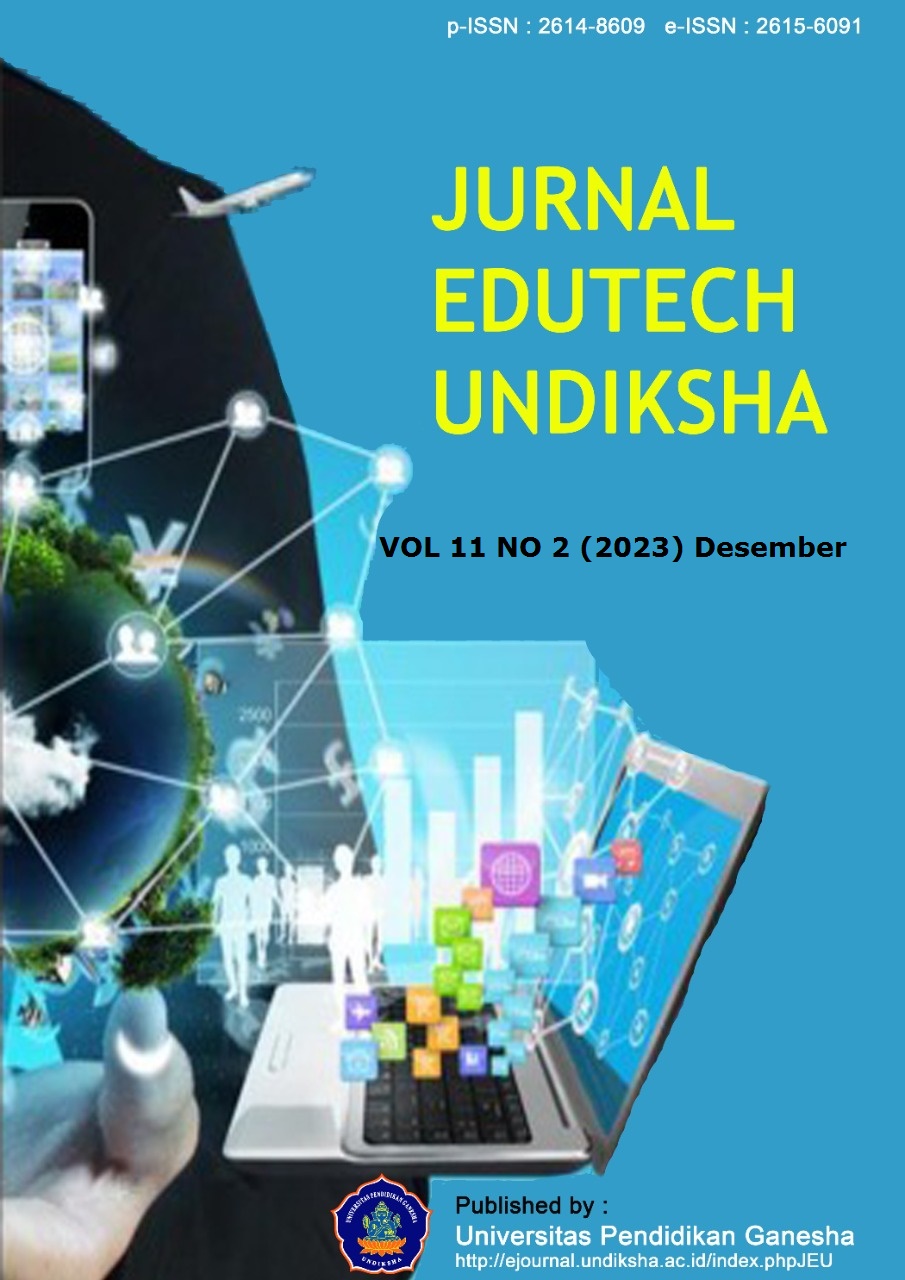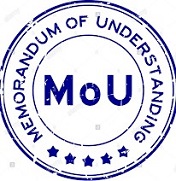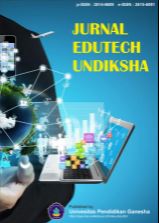Animated Video Based on Tri Hita Karana Fourth Grade Energy Sources Learning Topic
DOI:
https://doi.org/10.23887/jeu.v11i2.65160Keywords:
Learning Video, Tri Hita Karana, ScienceAbstract
The conventional learning process makes students feel bored and affects their knowledge competency. This research aims to create an animated video based on Tri Hita Karana on natural science energy sources. This research is development research by applying the ADDIE development model. The subjects of this research were student responses, 2 media experts, 2 materials experts, and 2 practitioners. This research uses a questionnaire or questionnaire data collection method to measure validity using a rating scale instrument. Data analysis methods and techniques in this research use qualitative and quantitative descriptive analysis. The validity test results of the animated video based on Tri Hita Karana on the topic of energy sources were obtained, the validity of which was tested with an average score of 4.69 for media experts, 4.68 for material experts, 4.69 for practitioner experts and student test results or average student responses average 5. In conclusion, the Tri Hita Karana-based animated video on learning energy sources is very good quality and suitable for fourth-grade science subjects in elementary schools. This research implies that it can facilitate students' understanding of energy source materials using animated video media.
References
Agung, AAG (2014). Educational Research Methodology. Aditya Media Publishing.
Agustin, R., Nurmalia, & Noviardila, I. (2021). The Role of Interactive Animation Media on Interest in Learning in Indonesian Language Subjects in Class IV Students of SD Negeri 019 Tanjung Sawit, Tapung District, Kampar Regency, Learning 2020/2021. Journal of Education and Counseling (Jpk), 3(1), 71–79. https://doi.org/10.31004/jpdk.v3i1.1385.
Aini, N., Zuliani, R., & Rini, CP (2021). The Influence of Animation Video Media on Science Learning Outcomes of Class IV Students at Sdn 20 Pagi, East Jakarta. NUSANTARA: Journal of Education and Social Sciences, 3(3), 417–426. https://ejournal.stitpn.ac.id/index.php/nusantara.
Ar, ARA, Bayu, GW, & Sudatha, IGW (2021). Video-Based Learning on PPKn Education with the Topic of Symbols and Meanings of Pancasila. International Journal of Elementary Education, 5(3), 384–392. https://doi.org/10.23887/ijee.v5i3.36703.
Artayana, MS, Tegeh, IM, & Bayu, GW (2022). Learning Videos Based on Tri Hita Karana Local Wisdom for Social Sciences Theme 7 Sub-Theme 2. Journal for Lesson and Learning Studies, 5(3), 351–359. https://doi.org/10.23887/jlls.v5i3.52567.
Azhar, A. (2014). Instructional Media. Jakarta: Rajagrafindo Persada.
Candra Dewi, NML, & Negara, IGAO (2021). Development of Science Animation Video Media on the Respiratory System Subject for Class V. Undiksha Edutech Journal, 9(1), 270–277. https://doi.org/10.23887/jeu.v9i1.32501.
Dewi, PDP, Agustika, GNS, & Suniasih, NW (2022). Ethnomathematics-Based Mathematics Learning Video Media for Material Introduction to Flat Figures for Class I Elementary School Students. EDUTECH Undiksha Journal, 10(1). https://doi.org/10.23887/jeu.v10i1.44775.
Diantari, NPM, & Gede Agung, AA (2021). Animated Video with the Tri Hita Karana Theme on Affective Aspects of Early Childhood. Journal of Early Childhood Education Undiksha, 9(2), 176. https://doi.org/10.23887/paud.v9i2.35497.
Didik Prawira Putra, IP, Manu Okta Priantini, DAM, & Astra Winaya, IM (2021). Development of Interactive Learning Animation Videos Based on Tri Hita Karana to Improve Elementary School Student Learning Outcomes. Citra Bakti Educational Scientific Journal, 8(2), 325–338. https://doi.org/10.38048/jipcb.v8i2.344.
Eleaser, J., Tegeh, IM, & Sudarma, IK (2023). Problem-Based Learning-Oriented Animated Learning Videos in Fifth-Grade Elementary School Science Content. Undiksha Edutech Journal, 11(1), 97–106. https://doi.org/10.23887/jeu.v11i1.58728.
Firmadani, F. (2020). Technology-Based Learning Media as a Learning Innovation in the Industrial Revolution Era 4.0. Proceedings of the National Education Conference, 2(1), 93–97. https://ejurnal.mercubuana-yogya.ac.id/index.php/Prosiding_KoPeN/article/view/1084.
Friska, SY, Amanda, MT, Novitasari, A., & Prananda, G. (2022). The Influence of Animation Videos on Student Learning Outcomes Class IV Science Learning Content at SD Negeri 08 Sungai Rumbai. PENDIPA Journal of Science Education, 6(1), 250–255. https://doi.org/10.33369/pendipa.6.1.250-255.
Gorda, ANES, & Anggria Wardani, DK (2020). Reflection on the Value of Local Wisdom of the Balinese Hindu Community in Environmental Management. ETTISAL : Journal of Communication, 5(1). https://doi.org/10.21111/ejoc.v5i1.3998.
Hamidah, S. (2019). Development of Science Learning Animation Media for Energy Material and Its Use for Class IV Elementary School Students" (research and development in class IV of Pasirpanjang 2 State Elementary School). Uin Smh Banten, 7–18.
Hasan, M., Harahap, TK, Susanti, & Khasanah, U. (2021). Educational Theory and Innovation. CV. Shahadah Creative Media (SCM).
Ilhami, RS, & Rimantho, D. (2017). Employee Performance Assessment using the AHP Method and Rating Scale. Journal of Industrial Systems Optimization, 16, 150–157. https://doi.org/10.25077/josi.v16.n2.p150-157.2017.
Izzaturahma, E., Mahadewi, LPP, & Simamora, AH (2021). Development of ADDIE-Based Animated Video Learning Media for Learning Theme 5 Weather for Class III Elementary School Students. Undiksha Edutech Journal, 9(2), 216. https://doi.org/10.23887/jeu.v9i2.38646.
Juwantara, RA (2019). Analysis of Piaget's Theory of Cognitive Development at the Concrete Operational Stage of Children 7-12 Years in Mathematics Learning. Al-Adzka: Scientific Journal of Madrasah Ibtidaiyah Teacher Education, 9(1), 27. https://doi.org/10.18592/aladzkapgmi.v9i1.3011.
Karmini, NW, Yudari, AAKS, Suasthi, IGA, Hadriani, NLG, & Setini, M. (2021). Model of Humanism Education based on Local Wisdom in Elementary School in Bali. International Journal of Early Childhood Special Education, 13(2), 1056–1063. https://doi.org/10.9756/INT-JECSE/V13I2.211150.
Kusuma, WM, Sudira, P., Hasibuan, MA, & Daryono, RW (2021). The Perceptions of Vocational School Students of Video Animation-Based Learning Media to Operate Lathes in Distance Learning. Journal of Educational Technology, 5(2), 200–206. https://doi.org/10.23887/jet.v5i2.33139.
Mahendra, IGE (2021). Making interactive student learning videos based on "CINTA" through SFH to increase motivation and biology learning outcomes. Indonesian Journal of Educational Development, 2(2), 290–301. https://doi.org/10.5281/zenodo.5244537.
Maranatha, JR, & Putri, DIH (2021). Early Childhood Empathy: The Effect of Using Animation Videos and Big Books in Kindergarten. Obsession Journal: Journal of Early Childhood Education, 6(3), 1991–1999. https://doi.org/10.31004/obsesi.v6i3.1881.
Mayang Ayu Sunami, & Aslam. (2021). The Effect of Using Zoom Meeting-Based Animation Video Learning Media on Primary School Students' Interest and Science Learning Outcomes. Basicedu Journal, 5(4), 1–9. https://doi.org/10.31004/basicedu.v5i4.1129.
Moreno-Guerrero, A.J., Rodríguez-Jiménez, C., Gómez-García, G., & Navas-Parejo, M.R. (2020). Educational innovation in higher education: Use of role playing and educational videos in future teachers' training. Sustainability (Switzerland), 12(6). https://doi.org/10.3390/su12062558.
Mudasih, I., & Subroto, WT (2019). Comparison of Student Learning Outcomes Through Video Learning Media with Powerpoint. International Journal of Educational Research Review, 4(2), 183–189. https://doi.org/10.24331/ijere.517997.
Mukholifah, M., Tisngati, U., & Ardhyantama, V. (2020). Developing Character Puppet Learning Media in Thematic Learning. Journal of Research Innovation, 1(4), 673–682. https://doi.org/10.47492/jip.v1i4.152.
Nanda, A., & Simamora, A.H. (2022). PMRI-Based Learning Video on Whole Number Counting Operations (VIORI) Material. Indonesian Journal of Instruction, 3(1), 42–53. https://doi.org/10.23887/iji.v3i1.52101.
Parmajaya, IPG (2020). Strengthening Character Education Based on Local Wisdom Tri Hita Karana for Hindu Students. Widyacarya: Journal of Education, Religion and Culture, 4(1), 11–17. https://doi.org/10.55115/widyacarya.v4i1.546.
Pebriani, NLP, Japa, IG, & Antara, P. (2021). YouTube Assisted Learning Videos to Increase Students' Interest in Learning about Changes in the Form of Objects. MIMBAR PGSD Undiksha, 9(3), 397. https://doi.org/10.23887/jjpgsd.v9i3.37980.
Pramesty, PE, Chasanatun, TW, & Laksana, MSD (2022). The Influence of Animation Video-Based Learning Media on Thematic Learning Outcomes of Elementary School Students. Proceedings of the Basic Sciences Conference, 3, 823–833.
Prasetyo, S. (2017). Development of Android-Based Science Learning Media for Elementary School Students. JMIE (Journal of Madrasah Ibtidaiyah Education), 1(1), 122–141. https://doi.org/10.32934/jmie.v1i1.29.
Pratiwi, MS, Zulherman, & Amirullah, G. (2021). The Use of the Powtoon Application in Learning Videos for Elementary School Students. Journal of Physics: Conference Series, 1783(1). https://doi.org/10.1088/1742-6596/1783/1/012115.
Prawira, IPD (2021). Development of Interactive Learning Animation Videos Based on Tri Hita Karana to Improve Elementary School Student Learning Outcomes. Citra Bakti Educational Scientific Journal, 8(2), 325–338. https://doi.org/10.38048/jipcb.v8i2.344.
Rai, IB, Sila, IM, Brata, IB, & Sutika, IM (2022). Building the Character Profile of Pancasila Students Based on Tri Hita Karana in a Global Life Perspective. Pulpit Science, 27(3), 417–425. https://doi.org/10.23887/mi.v27i3.54307.
Sadikin, A., & Hakim, N. (2019). Textbooks Assisted with the Learning Model Everyone is a Teacher Here: Efforts to Improve the Basic Teaching Skills of Prospective Biology Teachers. Assimilation: Indonesian Journal of Biology Education, 2(2), 47–51. https://doi.org/10.17509/aijbe.v2i2.19249.
Sari, NKCP (2022). Powtoon Animation Video Based on Contextual Approach in Elementary School Mathematics Learning. MIMBAR PGSD Undiksha, 10(2), 308–317. https://doi.org/10.23887/jjpgsd.v10i2.47337.
Schubertová, K., Lukavský, J., Drobná, A., Volná, K., & Brom, C. (2023). Contextual Animation in Multimedia Learning Materials For Pre-adolescents: The Saga of Null Results Continues. Learning and Instruction, 87, 101803. https://doi.org/10.1016/j.learninstruc.2023.101803.
Semara, TA, & Agung, AAG (2021). Development of Animation Videos for Class IV Elementary School Science Lesson Content. Undiksha Science Forum, 26(1), 99–107. https://doi.org/10.23887/mi.v26i1.32104.
Setiono, P., & Rami, I. (2017). Teacher Creativity in Using Learning Media in Class V Elementary Schools. Genta Journal of Elementary Education, 2(2), 219–236. https://doi.org/10.22437/gentala.v2i2.6808.
Sukarini, K., & Manuaba, IBS (2021). Development of Online Learning Animation Videos for Class VI Elementary School Science Subjects. Undiksha Edutech Journal, 9(1), 60–68. https://doi.org/10.23887/jeu.v9i1.32347.
Supartayasa, IKR, & Wibawa, IMC (2022). Learning the Water Cycle with Digital Comic Media Based on Tri Hita Karana. Journal of Pedagogy and Learning, 5(1), 127–137. https://doi.org/10.23887/jp2.v5i1.46279.
Supriyani, MD, Japa, IGN, & Margunayasa, IG (2021). Improving Learning Outcomes on Globalization Material for Class VI Elementary School Students with Learning Video Media. Pulpit of Science, 9(3). https://doi.org/10.23887/mi.v26i3.39964.
Suwastawan, IGA, Renda, NT, & Laba Jayanta, IN (2022). Animated Video on the Topic of Plants and Their Functions in Science Learning. MIMBAR PGSD Undiksha, 10(2), 201–209. https://doi.org/10.23887/jjpgsd.v10i2.48901.
Swari, IGAAM, & Ambara, D.P. (2022). Animated Video Recognizing Letters and Numbers to Stimulate Early Childhood Cognitive and Language Abilities. Undiksha Journal of Early Childhood Education, 10(1), 163–172. https://doi.org/10.23887/paud.v10i1.47346.
Taqiya, Nuroso, & Reffiane. (2019). The Influence of the Connected Type Integrated Learning Model Assisted by Animation Video Media. Pulpit PGSD Undiksha, 7(3), 289–295. https://doi.org/10.23887/jjpgsd.v7i3.19492.
Tegeh, IM, & Sudatha, IGW (2019). Learning Design Models. Ganesha University of Education.
Tiarini, NP, Dantes, N., & Yudiana, K. (2019). The Influence of the Tri Hita Karana Oriented Problem Based Learning (PBL) Learning Model on Science Learning Outcomes. Pulpit Science Journal, 24(3), 299–309. https://doi.org/10.23887/mi.v24i3.21422.
Valentina, NPD, & Sujana, IW (2021). Animated Learning Videos Based on Role Playing on Professional Themes in Early Childhood. Journal of Early Childhood Education Undiksha, 9(2), 231. https://doi.org/10.23887/paud.v9i2.35640.
Wardani, RK, & Syofyan, H. (2018). Development of Interactive Videos in Integrative Thematic Science Learning on Human Blood Circulation Material. Elementary School Science Journal, 2(4), 371–381. https://doi.org/10.23887/jisd.v2i4.16154.
Widnyana, IG (2018). The Influence of the Tri Hita Karana Based Role Playing Learning Model on the Social Sciences Knowledge Competency of Class IV Students at Gugus Untung Surapati Elementary School. Primary School Scientific Journal, 2(1), 30. https://doi.org/10.23887/jisd.v2i1.13894.
Wulandari, MP (2019). Effectiveness of Using Elementary School Science Animation Video Media Based on Science Literacy on Class IV Student Learning Outcomes. PANCAR, 3(2), 264–274. https://ejournal.unugha.ac.id/index.php/pancar/article/view/307.
Downloads
Published
How to Cite
Issue
Section
License
Copyright (c) 2023 I Made Gunawan Wahyu Adi Pranata, I Kadek Suartama, Kadek Yudiana

This work is licensed under a Creative Commons Attribution-ShareAlike 4.0 International License.
Authors who publish with the Jurnal EDUTECH Undiksha agree to the following terms:
- Authors retain copyright and grant the journal the right of first publication with the work simultaneously licensed under a Creative Commons Attribution License (CC BY-SA 4.0) that allows others to share the work with an acknowledgment of the work's authorship and initial publication in this journal.
- Authors are able to enter into separate, additional contractual arrangements for the non-exclusive distribution of the journal's published version of the work (e.g., post it to an institutional repository or publish it in a book), with an acknowledgment of its initial publication in this journal.
- Authors are permitted and encouraged to post their work online (e.g., in institutional repositories or on their website) prior to and during the submission process, as it can lead to productive exchanges, as well as earlier and greater citation of published work. (See The Effect of Open Access)














